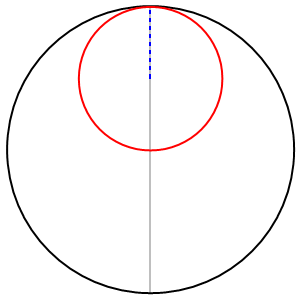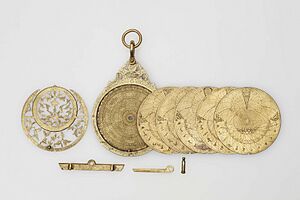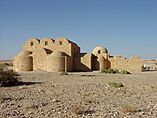Astronomy in the medieval Islamic world facts for kids
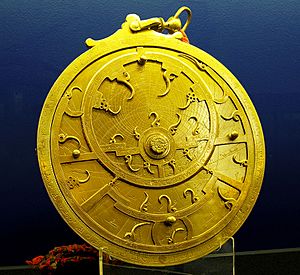
Medieval Islamic astronomy refers to the amazing discoveries and advancements in astronomy made in the Islamic world. This happened especially during the Islamic Golden Age, which was from the 9th to the 13th centuries. Most of these writings were in the Arabic language. These developments took place in places like the Middle East, Central Asia, Al-Andalus (Spain), and North Africa. Later, they spread to the Far East and India.
Islamic astronomy built upon ideas from ancient Greek, Persian, and Indian works. These older texts were translated into Arabic and then improved upon. Islamic astronomy was very important because it helped bring back ancient knowledge that was lost during the early medieval period. Many Arabic works were translated into Latin in the 12th century, which helped spread this knowledge to Europe. Islamic astronomy also influenced Chinese astronomy.
Even today, many stars, like Aldebaran, Altair, and Deneb, still have their Arabic names. Also, many astronomy terms, such as alidade, azimuth, and nadir, come from Arabic. There are about 10,000 old manuscripts about Islamic astronomy around the world. Many of these have not yet been studied. However, we can still get a good idea of how much Islamic scholars contributed to astronomy.
Contents
History of Islamic Astronomy
Early Beginnings
Before Islam, Arabs mainly used simple observations of stars. They watched when certain stars rose and set. This tradition was called Anwā’. They did not have complex math systems like the Babylonians or Greeks. After Islam spread, Arab astronomers started using mathematics in their study of the night sky.
The first astronomy books translated into Arabic came from India and Persia. One important book was Zij al-Sindhind. It was translated around 770 AD with help from Indian astronomers. Another important book was Zij al-Shah, which was based on Persian astronomical tables. During this time, Arab astronomers started using the sine function from India. This was different from the chords used in Greek math.
Ptolemy's Almagest was a major Greek work about a geocentric (Earth-centered) universe. It was translated into Arabic at least five times in the late 700s and 800s. This book became a main guide for Arabic astronomy.
The rise of Islam also encouraged progress in astronomy. Muslims needed to know the five daily prayer times and the qibla. The qibla is the direction towards the Kaaba in Mecca. Finding these directions accurately required good astronomical knowledge.
The Golden Age of Astronomy
The House of Wisdom was a famous center for learning in Baghdad. It was set up by Caliph Al-Ma'mun in the early 800s. Al-Ma'mun strongly supported astronomy research there.
The first major Muslim astronomy book was Zij al-Sindhind. It was written by the mathematician Muhammad ibn Musa al-Khwarizmi in 830. This book had tables showing the movements of the Sun, Moon, and planets like Mercury, Venus, Mars, Jupiter, and Saturn. This work brought Ptolemy's ideas into Islamic science. It was a big step because Islamic astronomers then started to create new ideas, not just translate old ones.
Questioning Ptolemy's Ideas
By the 10th century, some texts began to question Ptolemy's theories. Islamic scholars wondered if the Earth really stayed still in the center of the universe. They could now do their own research into the Ptolemaic system.
In 850, the astronomer Al-Farghani wrote a book called Kitab fi Jawami. It summarized Ptolemy's ideas but also corrected some of them. Al-Farghani gave new values for things like the tilt of the Earth's axis and the Earth's circumference. His book was widely read and translated into Latin.
The Egyptian astronomer Ibn Yunus found mistakes in Ptolemy's math in the 10th century. Ptolemy thought the Earth's axial precession changed by one degree every 100 years. Ibn Yunus calculated it changed by one degree every 70 and a quarter years.
Between 1025 and 1028, the brilliant scholar Ibn al-Haytham wrote Al-Shukuk ala Batlamyus ("Doubts on Ptolemy"). He didn't say the Earth-centered model was wrong. But he criticized parts of Ptolemy's theories. Other astronomers then tried to solve the problems Ibn al-Haytham pointed out.
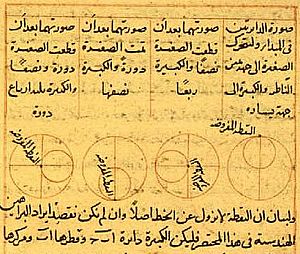
In 1261, Nasir al-Din al-Tusi wrote his Tadkhira. It listed 16 major problems he found with Ptolemy's astronomy. This inspired many Islamic scholars to try and fix these problems. Scholars like Qutb al-Din al-Shirazi, Ibn al-Shatir, and Shams al-Din al-Khafri created new models. These models were later used by many astronomers.
Nasir al-Din Tusi wanted to use the Tusi couple to replace Ptolemy's "equant" concept. The equant made the Moon's distance from Earth change too much. The Tusi couple allowed the Moon to rotate around Earth in a way that matched observations better. Another scholar, Mu'ayyad al-Din al-Urdi, came up with a concept called "lemma." This was another way to show the circular motion of planets without using Ptolemy's method.
Earth's Rotation
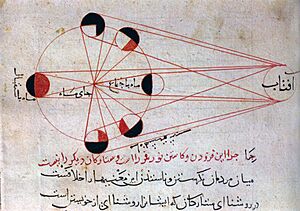
Abu Rayhan Biruni (born 973) thought about whether the Earth spun on its axis and orbited the Sun. However, in his main work, he stated that the Earth was at the center of the universe and did not move. He knew that if the Earth rotated, it would fit his calculations. But he saw this as a question of philosophy, not just math.
His friend, Abu Sa'id al-Sijzi, believed the Earth rotated on its axis. Al-Biruni even described an astrolabe that Sijzi invented based on the idea of a rotating Earth.
A 13th-century Arabic book confirms that some people believed the Earth moved. It said: "According to the geometers [or engineers], the earth is in a constant circular motion, and what appears to be the motion of the heavens is actually due to the motion of the earth and not the stars."
At the Maragha and Samarkand observatories, scholars like Najm al-Din al-Qazwini al-Katibi, Tusi, and Qushji discussed the Earth's rotation. Their arguments were similar to those used by Nicolaus Copernicus much later. However, the Maragha school never fully adopted the idea of a Sun-centered (heliocentric) universe.
Other Earth-Centered Systems
In the 12th century, some Islamic astronomers in Spain developed new Earth-centered models. These were alternatives to Ptolemy's system. They followed the ideas of scholars like Ibn Bajjah, Ibn Tufail, and Ibn Rushd.
One important astronomer was Nur ad-Din al-Bitruji. He thought Ptolemy's model was just mathematical, not physically real. Al-Bitruji tried to create a theory of planetary motion that avoided Ptolemy's complex circles (epicycles and eccentrics). He wasn't successful in replacing Ptolemy's model because his predictions for planet positions were less accurate. However, Al-Bitruji had a unique idea: he proposed a physical reason for why celestial bodies move. He believed the same rules of motion applied to both Earth and the heavens.
Later Period
In the late 1200s, Nasir al-Din al-Tusi created the Tusi couple, as shown in the images above. Other important astronomers from this later period include Mu'ayyad al-Din al-Urdi (around 1266), Qutb al-Din al-Shirazi (around 1311), Ibn al-Shatir (around 1375), and Ali Qushji (around 1474).
In the 15th century, the Timurid ruler Ulugh Beg of Samarkand was a great supporter of astronomy. He studied it when he was young. In 1420, he ordered the building of the Ulugh Beg Observatory. This observatory produced new astronomical tables and helped with other scientific and math discoveries.
Some major astronomy works were written in the early 1500s. These included works by Al-Birjandi and Shams al-Din al-Khafri. However, many works from this time are still waiting to be studied.
Influences of Islamic Astronomy
Europe

Many Islamic astronomy books were translated into Latin starting in the 12th century.
The work of al-Battani (died 929), called Kitāb az-Zīj ("Book of Astronomical Tables"), was often used by European astronomers. Nicolaus Copernicus, who proposed that the Sun was the center of the universe, mentioned al-Battani many times in his famous book. Other famous scientists like Tycho Brahe and Johannes Kepler also used al-Battani's work. His data is still used today in the study of Earth's physics.
Around 1190, al-Bitruji published his alternative Earth-centered system. This system became popular in Europe during the 13th century. Debates about his ideas continued until the 16th century. In 1217, Michael Scot translated al-Bitruji's book into Latin. This book became an important alternative to Ptolemy's Almagest for scholars. Copernicus even mentioned al-Bitruji's system in his own book.
Some historians believe that the ideas from the Maragha observatory, especially the Tusi couple, influenced European astronomy during the Renaissance. This includes Copernicus. Copernicus used similar mathematical tools in his models as those found in Arabic sources. For example, Copernicus's models for the Moon and Mercury are very similar to those of Ibn al-Shatir (died around 1375).
While the influence of Averroes's criticism of Ptolemy on Renaissance thought is clear, the direct influence of the Maragha school on Copernicus is still debated. However, since Copernicus used the Tusi couple, many agree he must have learned about it somehow. It's possible the idea came to Europe without many written records, perhaps through Byzantine science which translated some of al-Tusi's works into Greek.
China
Islamic astronomy first influenced Chinese astronomy during the Song dynasty. A Muslim astronomer named Ma Yize introduced the idea of seven days in a week and made other contributions.
During the Mongol Empire and the later Yuan dynasty, Islamic astronomers were brought to China. They helped with making calendars and studying astronomy. Kublai Khan brought Iranians to Beijing to build an observatory.
Several Chinese astronomers worked at the Maragheh observatory in Persia, which was founded in 1259. In 1267, the Persian astronomer Jamal ad-Din brought seven Persian astronomical instruments to Kublai Khan. These included a globe and an armillary sphere. He also brought an astronomical almanac. Jamal ad-Din became the first director of the Islamic observatory in Beijing in 1271. This observatory worked alongside the Chinese one for 400 years. Islamic astronomy was highly respected in China for its accurate predictions of eclipses and its theories about planetary latitudes, which Chinese astronomy didn't have at the time.
Some of the instruments built by the famous Chinese astronomer Guo Shoujing looked similar to those at Maragheh. His "simplified instrument" and the large gnomon at the Gaocheng Astronomical Observatory show signs of Islamic influence. When Guo Shoujing created the Shoushili calendar in 1281, his work in spherical trigonometry might have been influenced by Islamic mathematics.
During the Ming dynasty, Hongwu Emperor (ruled 1368–1398) brought Muslim and Han Chinese astronomy experts to Nanjing. He wanted to improve observation and calculation methods. The Ming court appointed several Muslim astrologers to high positions. They wrote many books on Islamic astronomy and made equipment based on the Islamic system.
In 1383, two important Islamic astronomy books were translated into Chinese. In 1384, a Chinese astrolabe was made based on Islamic designs. This led to the Huihui Lifa (Muslim System of Calendrical Astronomy), which was published in China many times until the early 1700s.
Korea
In early Joseon Korea, the Islamic calendar was used as a basis for calendar reform. It was more accurate than the existing Chinese calendars. A Korean translation of the Huihui Lifa was studied in Joseon Korea during the time of Sejong the Great in the 15th century.
Observatories
The first systematic observations in Islam happened under the support of al-Mamun. In Damascus and Baghdad, they measured degrees on the meridian, found solar parameters, and made detailed observations of the Sun, Moon, and planets.
In the 10th century, the Buwayhid dynasty encouraged a lot of astronomy work. They built large instruments for observations around 950. The great astronomer Abd al-Rahman al-Sufi was supported by Prince 'Adud al-Dawla. He carefully checked Ptolemy's list of stars. Sharaf al-Dawla also built an observatory in Baghdad. Reports from Ibn Yunus and al-Zarqali in Toledo and Cordoba show they used advanced instruments.
Malik Shah I built the first large observatory, probably in Isfahan. Here, Omar Khayyám and others created a zij (astronomical tables) and the Persian Solar Calendar, also known as the jalali calendar. A modern version of this calendar is still used in Iran and Afghanistan.
The most important observatory was built by Hulegu Khan in the 13th century. Nasir al-Din al-Tusi oversaw its construction at Maragha. This place had rooms for Hulagu Khan, a library, and a mosque. Top astronomers worked there and made important changes to Ptolemy's system over 50 years.
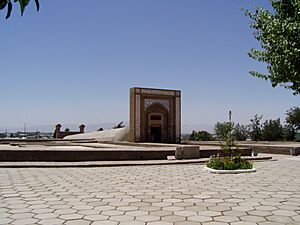
In 1420, Prince Ulugh Beg, who was also an astronomer and mathematician, built another large observatory in Samarkand. Its remains were found in 1908.
Finally, Taqi al-Din Muhammad ibn Ma'ruf built a large observatory in Ottoman Constantinople in 1577. It was as big as the ones in Maragha and Samarkand. However, it was destroyed in 1580. While the Ottoman religious leaders didn't mind astronomy itself, they opposed the use of the observatory for astrology, which led to its destruction.
As observatories grew, Islamic scientists also started to create planetariums. An observatory lets you look up at the night sky. A planetarium, however, projects the universe, planets, and stars at eye-level in a room. Scientist Ibn Firnas created a planetarium in his home. It was made of glass and even had artificial storm noises. This was the first of its kind and similar to modern planetariums.
Instruments
We know about the instruments Muslim astronomers used from two main sources. First, there are the actual instruments still found in museums and private collections. Second, there are old writings and manuscripts from the Middle Ages. Muslim astronomers improved many instruments that existed before their time. They added new scales and details.
Celestial Globes and Armillary Spheres
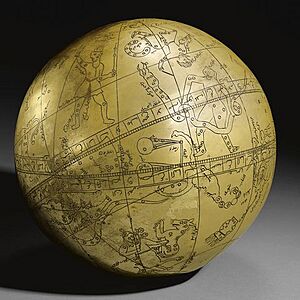
Celestial globes were mainly used to solve problems in sky astronomy. Today, 126 of these instruments still exist. The oldest one is from the 11th century. You could use them to find the height of the Sun or the position of stars. The idea for a portable celestial globe came from the Spanish Muslim astronomer Jabir ibn Aflah (died 1145).
Another skilled Muslim astronomer who worked on celestial globes was Abd al-Rahman al-Sufi (born 903). His book, Book of Fixed Stars, explains how to draw constellations on the globe and how to use it. However, in 10th-century Iraq, the astronomer Al-Battani used celestial globes to record data about the sky. Before this, globes were mainly for observing. Al-Battani's book describes how to plot the positions of 1,022 stars.
An armillary sphere had similar uses. No early Islamic armillary spheres have survived. But several books were written about "the instrument with the rings." There was also an Islamic invention called the spherical astrolabe. Only one complete one from the 14th century still exists.
Astrolabes
Brass astrolabes were invented in ancient times. The first Islamic astronomer known to have built an astrolabe was Muhammad al-Fazari in the late 700s. Astrolabes were very popular in the Islamic world during the "Golden Age." They were mainly used to find the qibla (direction of prayer). The oldest known Islamic astrolabe is from 927/8 AD.
This device was incredibly useful. Around the 10th century, it was brought to Europe from the Muslim world. It inspired European scholars to become interested in math and astronomy.
The main purpose of an astrolabe is to be a portable model of space. It can calculate the approximate location of any heavenly body at any time. You just need to know your latitude. Astrolabes often had extra plates that users could swap to match their location. One of its most useful features is that it lets users solve complex math problems graphically. This meant people could do advanced calculations without needing difficult spherical trigonometry.
Astrolabes also helped ships at sea find their position. Standard astrolabes didn't work well on bumpy waters. So, a new version, called a Mariner's astrolabe, was developed for sea travel.
al-Zarqali of Andalusia built an astrolabe that could be used anywhere, no matter the observer's latitude. This instrument became known in Europe as the Saphea.
The astrolabe was probably the most important instrument for astronomy in the medieval period. Its invention required a lot of study and trial and error. Its creation led to many math advancements. The astrolabe's original purpose was to find the height of the sun and visible stars. But it also helped map the globe, which led to more sea exploration. This, in turn, led to many positive events that shaped the world we know today.
The astrolabe needed math to work. Its development included azimuth circles, which led to more math questions. Astrolabes helped find the direction of Muslim prayer (Mecca). They also greatly influenced navigation, especially at sea. This made calculating latitude easier, which boosted sea exploration. Indirectly, this helped lead to the Renaissance, increased global trade, and the discovery of several continents.
Mechanical Calendar
Abu Rayhan Biruni designed an instrument he called "Box of the Moon." It was a mechanical lunisolar calendar. It used a gear train with eight gear-wheels. This was an early example of a machine that processed information.
Sundials
Muslims made many important improvements to sundials. They learned about sundials from Indian and Greek cultures. Khwarizmi made tables for these instruments, which greatly reduced the time needed for calculations.
Sundials were often placed on mosques to help determine prayer times. A striking example was built in the 14th century by ibn al-Shatir, the timekeeper of the Umayyad Mosque in Damascus.
Quadrants
Muslims invented several types of quadrants. These included the sine quadrant for astronomy calculations and various forms of the horary quadrant. Horary quadrants were used to tell time by observing the Sun or stars. Baghdad in the 9th century was a center for developing quadrants.
Abu Bakr ibn al-Sarah al-Hamawi (died 1329) was a Syrian astronomer. He invented a quadrant called “al-muqantarat al-yusra.” He wrote many books about his work with quadrants and geometry. These instruments could measure the height between a celestial object and the horizon. Muslim astronomers found other uses for them too. For example, the mural quadrant recorded the angles of planets. The universal quadrant solved astronomy problems based on latitude. The horary quadrant found the time of day using the sun. The almucantar quadrant was developed from the astrolabe.
Equatoria
Planetary equatoria were probably made by ancient Greeks, but no descriptions from that time have survived. The first known description of a planetary equatorium is in an early 11th-century book by Ibn al-Samh. This book was preserved as a 13th-century Spanish translation. The same book also has a 1080/1081 book about the equatorium by Al-Zarqali.
Astronomy in Islamic Art
Islamic art shows many examples of space-related images. These can be found in manuscripts, astrology tools, and palace frescoes. The study of the heavens by Islamic astronomers led to artistic pictures of the universe and astrology. The Islamic world got ideas from Greek, Iranian, and Indian traditions to show stars and the universe.
The desert castle at Qasr Amra, which was a Umayyad palace, has a bath dome decorated with the Islamic zodiac and other sky designs.
The Islamic zodiac and astrology images can also be seen in metalwork. Ewers (water pitchers) showing the twelve zodiac symbols were made to show skilled craftsmanship and bring good luck. Coins also had zodiac images to show the month they were made. So, astrological symbols were used for both decoration and to share symbolic meanings or specific information.
Notable Astronomers
Here are some of the important astronomers from the medieval Islamic world:
- Al-Khwarizmi
- Al-Farghani
- Thābit ibn Qurra
- Al-Battani
- Al-Farabi
- Abd Al-Rahman Al Sufi
- Ibn Yunus
- Ibn al-Haytham
- Al-Biruni
- Avicenna
- Abū Ishāq Ibrāhīm al-Zarqālī
- Omar Khayyám
- Nur Ed-Din Al Betrugi
- Averroes
- Nasir al-Din al-Tusi
- Ibn al-Shatir
- Ulugh Beg
- Ali Qushji
- Taqi al-Din Muhammad ibn Ma'ruf
See Also


